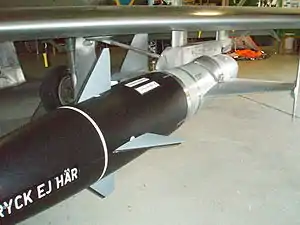RB 04
The RB-04 (Robot 04) is a long-range fire-and-forget air-to-surface, anti-ship missile. The missile was known as the "RB-304" during development and early service years.
| RB-04E | |
|---|---|
 | |
| Type | Fire and forget anti-ship |
| Place of origin | Sweden |
| Service history | |
| In service | 1962-2000? |
| Used by | Sweden |
| Production history | |
| Manufacturer | SAAB |
| Specifications | |
| Mass | 600 kg (1,300 lb) |
| Length | 4.45 m (14 ft 7 in) |
| Diameter | 50 cm (20 in) |
| Warhead | 300 kg (660 lb) HE blast and pre-fragmented |
Detonation mechanism | impact or proximity |
| Engine | INI Solid Rocket Engine |
| Wingspan | 2.04 m (6 ft 8 in) |
| Propellant | Solid |
Operational range | 32 km (20 mi) |
| Flight altitude | sea skimming Rb04E |
| Maximum speed | subsonic |
Guidance system | active radar homing, Track on Jam (AGA-1 seeker, Rb04C) |
Launch platform | Aircraft A 32, AJ 37, AJS 37 |
While interest in guided anti-ship missiles was subdued in the 1950s, it was not entirely extinct. In 1949, the Swedish government placed a request for a radar-guided, air-launched anti-ship missile. The request materialized as the SAAB "Robot-Byrån (RB) 04", which was first test launched by a Saab 29 Tunnan fighter in early 1955. The early versions of the missile suffered teething problems in regards to the two targeting modes, which were area attack, for striking a big group of ships (like an invasion fleet), and select targeting, where the missiles home in on a single vessel. In the area attack the missile would only target a ship in the group if they were within 1,000 meters of another vessel, this was also in the early electronic age, and changes in this distance required hardware modifications in a workshop.
- RB-04C: The initial production version, the "RB-04C", entered service with Swedish Air Force A 32A Lansen attack aircraft in 1959. The RB-04C had a canard configuration, with short triangular cruciform fins around the nose, and two wide wings with fins attached to the wingtips. The RB-04C had a boost-sustain solid rocket motor and a SAP warhead that could be fitted with a contact or proximity fuse.
- RB-04D: Further development of the C version. Longer range rocket engines and maintenance free thermal batteries where the main improvements. Introduced in the late 1960s.
- RB-04E: Further development of the D version to suit the new AJ37 Viggen strike aircraft. The missile had a shorter wingspan and improved guidance system and new monopulse radar seeker, which allowed sea-skimming approaches. This version was highly resistant to ECM and would automatically lock on especially powerful jamming signals.

Many components of the missile were reused when the RBS-15 was developed, including the main body and warhead, although the motor and main wings were the most obvious external changes.
The missile has never seen combat; the closest thing it has come to being used was during the "Whiskey on the Rocks" incident in 1981, when a Soviet (NATO code Whiskey Class) submarine ran aground outside the naval station in Karlskrona. Swedish AJ37 Viggens with RB-04E's mounted under their wings, taken from top secret storage bunkers, stood on high alert for a possible Soviet incursion. On one occasion, when a Soviet rescue operation seemed to be underway, aircraft were scrambled with the intent to intercept Soviet ships.
References
- Svenskt Militärflyg - Bo Widfeldt / Åke Hall (2005)
- An Illustrated Guide To Modern Airborne Missiles - Bill Gunston, Arco Publishing, Inc. (1983)
External links
- "Swedish Air Force Has Rocket Powered Missiles" Popular Mechanics, April 1958, p. 112, photo caption is wrong in stating that it is an air-to-air missile.